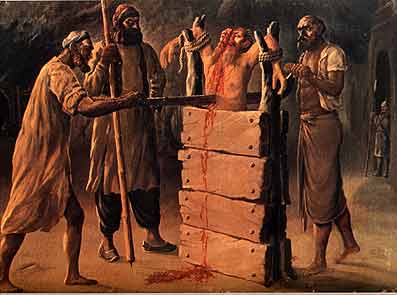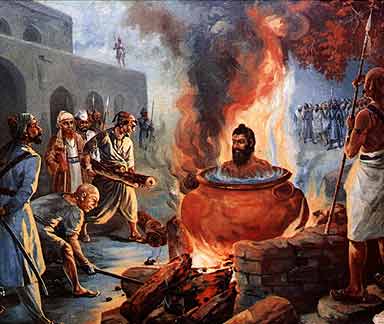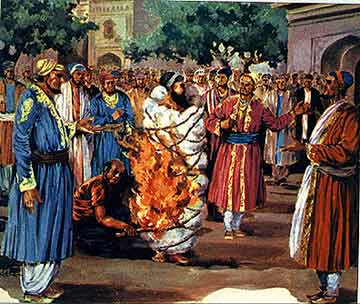
GuruTeg Bahadur saheb, after being arrested in Agra and brought to Delhi,
was thrown into prison where he was asked to embrace Islam. This he refused
to do. Aurangzeb had many religious disputa-tions, intending to convince the
Guru, but to no avail. The Emperor finally asked the Guru either to renounce
his own faith and embrace Islam or to show miracles if he wanted to live.
Guru saheb declined to do either. He replied, "Freedom of faith and worship
is the right of every individual. No ruler should kill those who believe in
a different doctrine or ideology." With regard to showing miracles, the
Guru said, "God only performs miracles; it is not for man to inter-fere
with His Will."
When Guru Teg Bahadur saheb refused to convert to Islam, Aurangzeb ordered
that the Guru be tortured. He was put in an iron cage and kept hungry for
several days. He was subjected to many humiliations and tortures. On November
10, 1675 the Guru was brought to the open place in front of the KotwaIi (police
station). There, the most heinous and horrible scene was enacted before the
eyes of the Guru in order to frighten him. Aurangzeb thought that the sight
of the ghastly execution of Bhai Mati Das might force the Guru to change his
mind and embrace Islam.

Bhai Mati Das was brought in front of the Kotwali, at Chandni Chauk. He was asked to embrace Islam or face death. He re-fused to embrace Islam, saying, "There is only one religion, the religion of God. Whosoever belongs to it, be he a Hindu or a Muslim belongs to the true religion. A truly religious man neither converts others by force, nor changes his faith by submitting to force. Everyone has a right to live accord-ing to one's faith. I shall not embrace Islam even if I am put to death."
On hearing such a daring and challeng-ing reply, the Qazi, Emperor's religious offi-cial, ordered the execution of Bhai Mati Das. He was tied between two posts, and while standing erect, was sawn through from head to loins. When the executioners began to apply the saw to his head, he started ut-tering Waheguru and became silent when he could no longer speak.
Bhai Mati Das faced the savage opera-tion with great composure, tranquillity, and fortitude. Thus, he attained martyrdom for the right of freedom of faith. The square where Bhai Mati Das was martyred stands today with a fountain. It is now named Chauk Bhai Mati Das in his honour. He is also remembered in the daily ardas (supplication) of the Sikhs to this day.

After the ghastly execution of Bhai Mati Das, the Head Qazi asked Guru Teg Bahadur Saheb to embrace Islam or die in a torturous way. Guru Saheb replied, "I neither frighten anyone, nor do the threats of death frighten me. This body is made of dust and it returns to dust." On hearing this, the Emperor's Chief Qazi ordered the exe-cutioner to bring Bhai Dyala, a devoted Sikh of the Guru.

Hearing this, the Chief Qazi became very an-gry, and asked the executioner to bring a caul-dron full of water. The cauldron was put on fire, and when the water in the cauldron began boil-ing, the Qazi ordered Bhai Dyala to be tied up like a bundle with iron chains and thrown in the boiling cauldron. The executioner followed the orders, and threw Bhai Dyala into the cauldron. Bhai Dyala remained calm and kept uttering "waheguru, waheguru-, waheguru, waheguru, waheguru- His martyrdom is still remem-bered by the Sikhs today in their daily prayers.

Guru Teg Bahadur Saheb watched the gruesome execution of Bhi Mati Das and Bhai Dyala. He knew that such sacrifices would not go in vain. Their names would shine forever, and a nation of noble heroes would arise out of the blood of these martyrs.
The Emperor's Chief Qazi again approached the Guru and asked him if he would embrace Islam and avoid a dreadful death. Guru Saheb said, "If you are trying to scare me with your hideous ways of executions, know that there is no pain for those who remain at the source of ex-istence. The tortures of body and mind cannot affect the spirit. Therefore do not waste your time in trying to persuade me to abandon my faith."

Bhai Sati Das was the brother of Bhai Mati Das and son of Bhai Piraga. When Sati Das was brought there, the Qazi asked him to either embrace Islam or face death by burning in fire. Sati Das, who was calm, composed, and unaffected by the Qazi's threat, said, "My Guru has taught me to respect everyone's right to freedom of faith. To coerce anyone to renounce one's faith and convert to another faith is against human dignity. All human beings are equal and free to choose their way of worship and live by the doctrine of their religion. I believe that there is but One God, the sole Supreme Being, and all of us whether Hindu, Muslim, or Sikh by re-ligion are the children of the same God. To claim that one's own religion is the only true religion is irra-tional and fanatic. Because you do not believe in the brother-hood of mankind, or in man's freedom of faith and worship, and have no tolerance for others' religion, I am not going to submit to your will and renounce my faith. I would rather die with dignity as a Sikh of my beloved Guru than to live in shame by converting."
Hearing this sermon from Sati Das, the Chief Qazi felt uneasy and restless. Going mad with anger, he ordered the execution of Bhai Sati Das. The executioner wrapped Bhai Sati Das with cot-ton and set him on fire. But Bhai Sati Das, a devout disciple of the Guru, remained wholly calm and peaceful, and kept on uttering Waheguru, waheguru-, waheguru-, waheguru, Waheguru.
His body was consumed by fire but his immortal soul remained in peaceful joy. His martyrdom is remembered by the Sikhs in their daily prayers.
Bhai Jaita, a Sikh living at Delhi, was present at the place of execution. Disguised as a sweeper with a broom and a basket, he collected the re-mains of these three martyrs during the pitch darkness of night and respectfully consigned them to the river Yamuna flowing nearby.
No people ought to claim that their religion is the only true religion. To force another to convert to one's own religion is a contemptible, fanatic act, and is the root cause of bloodshed in religious wars.
(Courtesy Dr. Santokh Singh-"The Guru's Word")